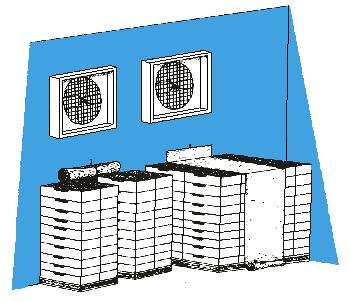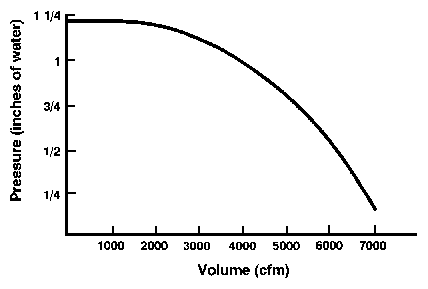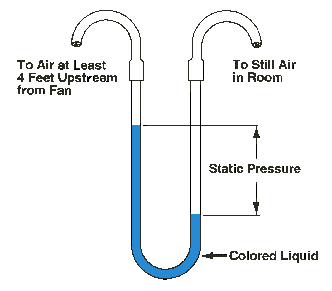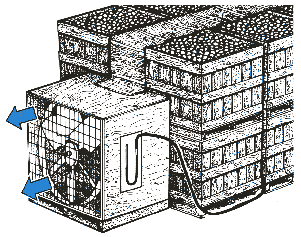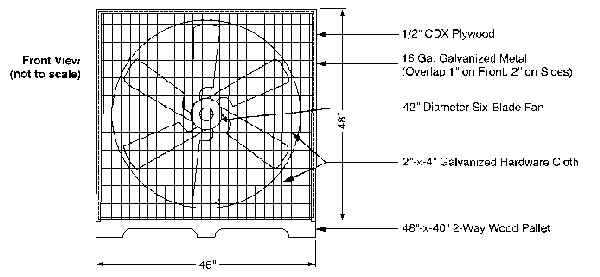For many years produce has been cooled by simply storing it in a refrigerated room, a process known as room cooling. This method is generally sufficient for keeping produce at a low temperature once it has been cooled, but it often does not remove field heat rapidly enough to maintain the quality of highly perishable crops. Room cooling is very often inadequate for produce stored in large containers, such as bulk boxes or pallet loads, and for produce that requires immediate cooling.
In the room cooling process, heat is removed slowly from only that produce near the outside of the container. Near the center of a container, heat is often generated by natural respiration more rapidly than it can be removed, causing the temperature to rise. Some types of produce, such as strawberries, must be cooled as quickly as possible after harvesting to preserve its fresh quality. Even a delay of several hours may be enough to reduce quality considerably. In such cases, room cooling is not fast enough to prevent serious damage.
To preserve quality, fresh produce should be cooled to its lowest safe (optimum) storage temperature as quickly as is practical and economical. Forced-air cooling is much faster than room cooling and is being used increasingly in North Carolina to cool produce quickly. It offers these advantages:
- It decreases the time the produce remains at elevated temperatures, thereby reducing deterioration;
- It results in shorter cooling times and thus more efficient use of the cooling facility;
- It can cool produce effectively in a variety of unopened containers without wetting it or subjecting it to excessive handling;
- It is often more energy efficient than room cooling when large volumes of produce must be cooled;
- An available room-cooling facility with adequate cooling capacity can be converted to forced-air cooling with only a relatively small investment in fans.
Energy-Efficient Cooling Practices
The energy cost for forced-air cooling can be greater or less than that for simple room cooling, depending on how carefully the system is used. The faster cooling possible with the forced-air method allows for greater use of the cooling facilities, reducing overall operating costs. In addition, since the amount of time required to cool a load of produce is much shorter, less energy is needed to remove heat produced by respiration and to overcome heat gain through the walls, ceiling, and floor of the building.
On the other hand, forced-air cooling is likely to increase the overall energy cost slightly by increasing electrical demand, a measure of the rate at which electricity is consumed. Demand cost contributes significantly to the electrical power bill for most cooling facilities. To reduce demand cost, produce should not be cooled any faster than necessary. Forced-air cooling can also increase cooling cost by increasing the cooling load per unit of time. Quicker cooling requires larger refrigeration units, the cost of which must be amortized over the life of the facility. The benefits of forced-air cooling, however, far outweigh the costs.
Forced-air cooling is a useful tool for preserving the quality of fresh produce. It is most effective when the produce demands quick cooling or when the amount of produce to be cooled per day or week is large enough to justify the increased equipment and electrical demand costs.
Cooling Rate
Forced-air cooling is accomplished by exposing packages of produce in a cooling room to higher air pressure on one side than on the other. This pressure difference forces the cool air through the packages and past the produce, where it picks up heat, greatly increasing the rate of heat transfer. Depending on the temperature, airflow rate, and type of produce being cooled, forced-air cooling can be from 4 to 10 times faster than room cooling.
The graph of time and temperature in Figure 1 illustrates the response of a typical commodity to airflow rates. The beginning temperature of the produce (pulp temperature) is represented by Ta. This temperature varies with ambient conditions and the amount of field heat in the produce; it normally ranges from 60 to 90°F.
The desirable air temperature inside the cooling room, Tb, depends primarily on the type of commodity. Few types of produce will tolerate temperatures below freezing, although some, such as strawberries and apples, require near-freezing storage temperatures. Many others, such as squash and cucumbers, will sustain chill injury if exposed to temperatures lower than 45°F.
The interior air temperature, Tb, is best measured by a thermometer positioned away from the exterior walls, ceiling, and produce containers. In practice, this temperature is regulated by the thermostat setting of the refrigeration system. Correct storage temperatures for most types of produce grown in North Carolina are given in Extension publication AG 414-1, Maintaining the Quality of North Carolina Fresh Produce: Introduction to Proper Postharvest Cooling and Handling Methods.
Curve A in Figure 1 represents the comparatively slow rate of cooling that can be expected without forced air movement (room cooling). Curves B and C demonstrate the increase in cooling rate possible with airflow rates of 1/2 and 1 cubic foot per minute per pound of produce, respectively.
The rate of cooling, represented by the slope of the curve, decreases as the produce temperature approaches the temperature of the room air. Reducing the temperature the last few degrees may take from several days to several weeks and is of little practical importance. In comparing cooling times for various methods, the time required to lower the pulp temperature to 7/8 of the difference between Ta and Tb is the value often used. On the graph, the 7/8 cooling time in still air is more than 7, compared to just over 1 for produce cooled with an airflow of 1 cubic foot per minute per pound of produce.
Since the cooling rate for a forced-air system is much greater than for room cooling, a refrigeration system of larger capacity may be required. Whether an existing system sized for room cooling will be sufficient for conversion to forced-air applications depends on a number of factors. These include the size of the original system, the anticipated future cooling loads, and the use factor of the facility. A qualified refrigeration contractor or a refrigeration specialist with Cooperative Extension can help in determining whether additional refrigeration capacity will be needed.
Air Management
Fans supplied with the refrigeration equipment are used to cool the air by forcing it past the evaporator coils. These fans are not large enough, nor are they properly located in most cases, to force air directly past the produce. Furthermore, the chilled air leaving the evaporator coils is generally much too cold for most types of produce. It must be mixed with the warmer air inside the room to prevent chill injury. Therefore, additional fans are required to move the air past the produce. To achieve good air distribution, these fans should pull, never blow, the cooled air through the produce as fast as practical.
Several different fan positions and produce stack-ing arrangements have proven successful for forced-air cooling. The shell arrangement shown in Figure 2 uses a portable pallet-mounted fan and is preferred by many because of its versatility. Two parallel rows of produce, positioned approximately 2 to 3 feet apart and covered by a cloth or plastic strip, form the shell. Cold air pulled through the produce flows through the space between the rows and out through the fan. In another arrangement known as the "cooling wall" (Figure 3), the fans are located permanently along one wall. This design might be more convenient for producers and shippers who handle large volumes of produce, especially if they always handle the same commodity or compatible ones. Both types of systems are widely used in North Carolina.
Because air is forced through the produce packages by the difference in air pressure between the opposite sides, it is necessary to fill the containers properly and stack them in such a way as to minimize voids and openings. Openings between containers allow the air to circumvent the produce, reducing cooling efficiency. Baffles may be positioned over unavoidable openings to direct the air through the produce. Double stacking should be avoided since even powerful forced-air fans have difficulty pulling air through more than one pallet width (3 to 4 feet) of produce.
In addition to controlling the temperature and airflow, it may be necessary to control the humidity. Moving air tends to remove water from the surface of produce, causing wilting, shrinkage, and general loss of quality and value. Most produce items require a relative humidity in the range from 90 to 98 percent if they are to be kept for more than a few hours in cold storage before shipment.
If the condensation from the evaporator coils is drained to the outside, the humidity in refrigerated rooms may become quite low. The amount of condensation that collects on these coils may be decreased substantially by limiting the temperature drop through them to 5°F. This can be accomplished by increasing the size or number of the coils. In practice, relative humidity levels above 80 or 85 percent cannot easily be achieved without some type of humidification system or very careful management.
Low humidity may be corrected by various types of commercial humidification systems. Many operators simply hose down the floors from time to time, but this approach may not be consistent with good sanitation nor particularly effective in many situations. On the other hand, excessively high humidity for long periods can also be detrimental because it encourages the growth of molds and fungi. Although a high-quality humidistat can be used to control the humidifier, the most consistently accurate method to measure relative humidity is with a wet-bulb thermometer. Construction details and directions for the proper operation of a wet-bulb thermometer may be obtained from your county Extension agent.
Fans
Not all fans are designed to move air at the volume and static pressure required for forced-air cooling. (Static pressure in this case is the resistance to air movement presented by the packages of produce.) Although either centrifugal ("squirrel cage") or propeller fans may be used, their specifications should be carefully evaluated to ensure that they will deliver an adequate quantity of cooling air at higher pressures. Fan curves giving pressure and volume data, such as the one shown in Figure 4, are available for most commercial or industrial fans. Notice that there is an inverse relationship between pressure and airflow rate. In the figure, for example, the flow rate at 1 inch of water pressure is 4,000 cubic feet per minute (cfm), whereas at a pressure of 1⁄2 inch the flow rate increases to over 6,000 cfm.
In addition to airflow rate and temperatures, several other variables influence the time required to cool produce with forced air, including the size and shape of the produce and the configuration and venting of the containers. In practice, however, an airflow rate of approximately 1 to 3 cubic feet per minute at 1⁄2 inch static pressure should be sufficient for most applications. Accurate cooling data for a specific set of conditions can be acquired only by conducting field tests.
The airflow rate through a fan system in a cooling setup may be measured with sufficient accuracy using an inexpensive U-tube manometer mounted to the fan (Figure 5 and Figure 6). U-tube manometers are designed to measure differences in air pressure. One side of the manometer is connected on the upstream side of the fan as far as possible from the blades and the other end is open to the room air. By knowing the static air pressure through the fan and consulting the performance chart usually supplied with new fans, the airflow rate may be accurately determined.
In addition, it is also useful to mount a thermometer on the downstream (exhaust) side of the fan. By comparing the temperature of the air as it exits the fan with the temperature of the room air, it is possible to determine the cooling rate. The following example will illustrate the procedure.
A manometer attached to a fan pulling air through 8,000 pounds of peppers shows a static pressure difference of 1⁄2 inch of water. The performance chart for this fan shows an airflow rate of 14,000 cubic feet per minute at this static pressure. The room air temperature is measured at 45°F and the temperature of the air exiting the fan is 52°F. Since raising the temperature of 54 cubic feet of air 1°F requires one Btu of heat energy:
Heat loss = [(14,000) x (52-45)] ÷ 54 = 1,815 Btu/minute
It takes approximately 1 Btu to lower the temperature of 1 pound of peppers 1°F. Therefore, at a heat loss rate of 1,815 Btu per minute, the temperature of the 8,000 pounds of peppers is being reduced approximately 1°F every 4.4 minutes.
The rate of heat loss changes continuously during the cooling period. As shown in Figure 1, it is greatest at the beginning of the cooling cycle (when the difference between product temperature and air temperature is greatest) and ultimately tapers off to zero.
The interior of a cooling room is often damp or even wet. Fan motors should therefore be of the totally enclosed, fan-cooled type (TEFC) and fully grounded according to local electrical codes to prevent shock.
It is also a good idea to control the fan with a line-voltage thermostat mounted in the airstream. The thermostat will stop the fan when the produce has cooled to a predetermined point, thus saving energy. It will also reduce the drying effects of the cooling air because it will not allow the fan keep running for an extended period after the produce has cooled. The thermostat should be set at 5 to 8°F above the temperature of the room air.
Plans and directions for building a portable pallet-mounted fan (similar to the one shown in Figure 6) are shown in Figure 7a and Figure 7b. This fan is capable of moving more than 11,000 cubic feet of air per minute against a static pressure of 3⁄8 inch of water. It is suitable for use in a variety of forced-air cooling applications.
Containers
A variety of produce packages have been used with forced-air cooling. They include fiberboard boxes, wooden wirebound crates and hampers, and bulk boxes. The only requirement is that sufficient open space be provided in the sides and bottom to ensure adequate air movement through the containers. Most commercial containers are designed with adequate open space. If not, openings should be added or enlarged so that 5 to 8 percent of the lateral surface and 3 to 5 percent of the bottom is open. Slots at least 1⁄2 inch wide are better than circular openings that may be blocked by produce. These openings should be well distributed over the surface of the container to ensure good air distribution.
Sponsored by the Energy Division, North Carolina Department of Commerce, with petroleum violation escrow funds, in cooperation with North Carolina Coopartive Extension, North Carolina State University. However, any opinions, findings, conclusions, or recommendations expressed herein are those of the authors and do not reflect the views of the Energy Division, North Carolina Department of Commerce.
Publication date: July 1, 1989
AG-414-03
N.C. Cooperative Extension prohibits discrimination and harassment regardless of age, color, disability, family and marital status, gender identity, national origin, political beliefs, race, religion, sex (including pregnancy), sexual orientation and veteran status.



